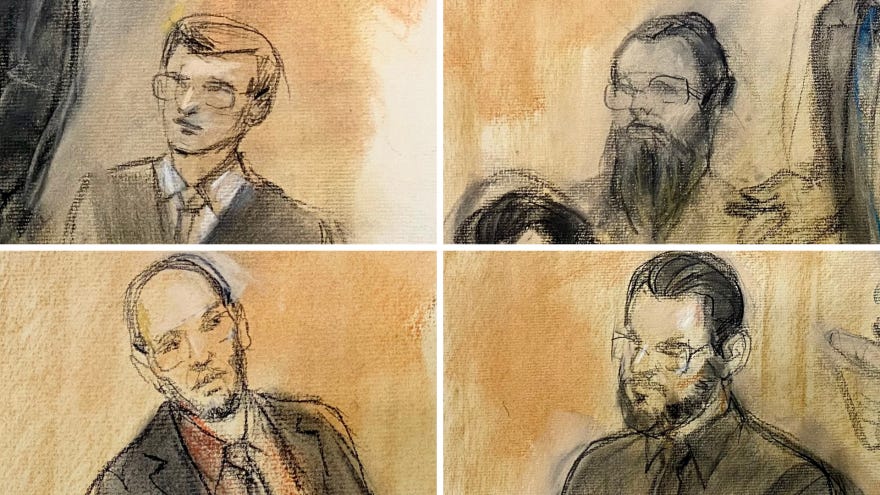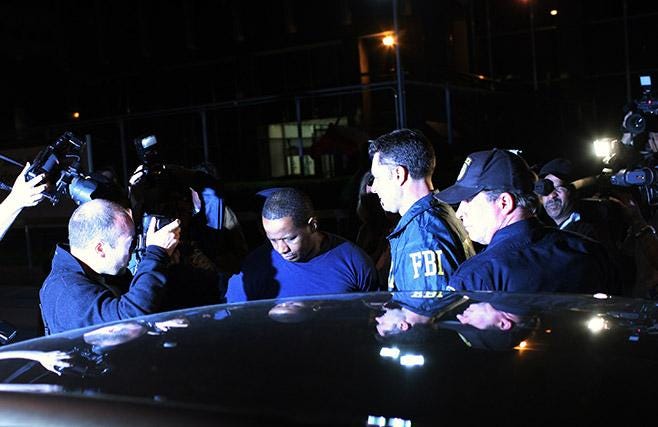The collapse of the "governor kidnapping" case highlights the racism of "counter-terrorism"

The collapse of the criminal trial in the Michigan “governor kidnapping plot” highlights the racism embedded within “counter-terrorism” in America. In this notorious case, the White men charged with this preposterous “governor kidnap plot” apparently convinced a jury that the FBI was mostly to blame for the fiasco. Compare that to the countless Black and Brown (usually Muslim) “terrorist” suspects “caught” by FBI informants: American juries never failed to convict these defendants, even if they presented clear evidence of police entrapment.
Over the past twenty years, the Department of Justice and FBI have aggressively used what investigative journalist Trevor Aaronson called a “terror factory” to allegedly entrap dozens of Muslims, who have been almost exclusively Black or Brown men. Here’s how it works. A confidential informant—one of thousands of shady characters “employed” by the FBI—hangs out with people in marginalized communities: in mosques, cafes, and bookstores. In several cases, the FBI informant has been so disruptive and dangerous that members of the Muslim community have called the police on them. Despite many controversies where these FBI informants have been caught stirring up trouble, the Supreme Court of the United States just endorsed this practice of “terrorist fishing expeditions” run by someone who owes the FBI a favor.
These FBI informants often come across people who need mental health care, or who have just lost a job, or who are struggling with addiction. If the FBI actually cared about public safety, perhaps these informants might direct these individuals to places where they can get support. But that’s not the purpose of “counter terrorism.” The purpose of “counter terrorism” is to find terrorist plots, and that’s just what these FBI informants find.
Eventually, this informant will “discover” a plot brewing—and sometimes it appears likely that the FBI informants even created the “terrorist plot” in the first place. Over the course of weeks (or longer), the FBI informant provides the “terrorists” with fake weapons, fake explosives, and maybe even know-how and encouragement. Then, just before the fake bomb would have blown up, the real FBI agents swoop in and make a dramatic arrest. The FBI then pats itself on the back, and declares that it has kept America safe—loudly rejecting arguments from civil rights advocates that the program is racist. All the while, the FBI’s annual budget for “counter-terrorism,” billions of dollars, flows freely.

Even after Human Rights Watch declared this FBI system “rife with abuse,” this pattern has played out again and again over the past twenty years. It’s likely that many of the terrifying plots you remember the FBI stopping came about because of one of these shady informants. There was the Newburgh Four, accused by the FBI of plotting to use missiles to shoot down jet airplanes. And the young man in Kansas who, an FBI informant said, plotted to attack a military base. There’s the man who, the FBI said, would have “beheaded” police officers in Boston, but he was killed by the FBI after the informant’s plans apparently went haywire. Perhaps you remember the Portland Christmas Tree bomber, who actually had a fake bomb provided by the FBI.
And now, of course, you will remember the “Michigan governor kidnapping,” again, involving an FBI informant. This time, however, the “terrorists” were White and right-wing activists. When these defendants argued, in court, that the FBI entrapped them—that is, the FBI created the crime and then arrested the defendants as criminals—the jury seems to have at least partially agreed. Previously, no other accused terrorists had ever successfully used the entrapment defense at trial, according to a 2019 study.
The racist stereotype of “the terrorist,” it seems, gave the FBI and criminal prosecutors a helping hand with Black and Brown defendants—but not in this “Michigan governor kidnapping” case. The FBI’s spectacular failure should provoke a re-evaluation of the entire concept of “counter terrorism,” and it should mark the end of the use of confidential informants.
Of course, the actual, difficult work of counter-terrorism must continue, because the threat of terrorism—from all kinds of violent extremists—remains all too real. But relying on the FBI’s network of shady informants to conduct fishing expeditions, clearly, does not work. Too many people have been imprisoned for fake plots, while some actually deadly groups have been ignored until it’s too late.


